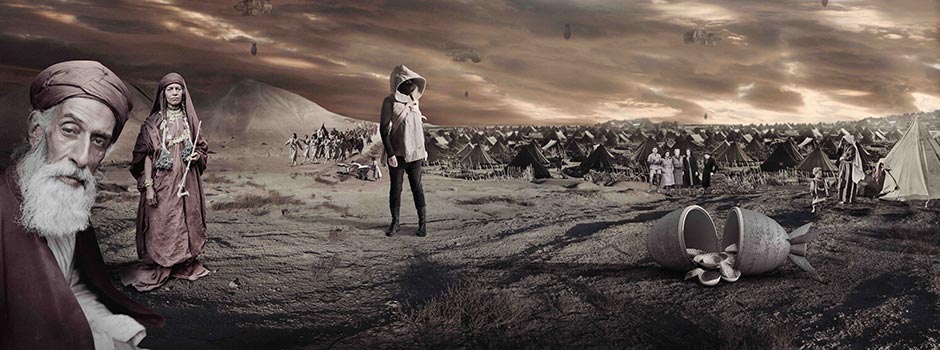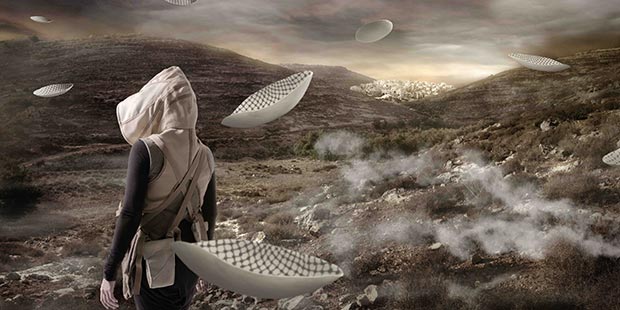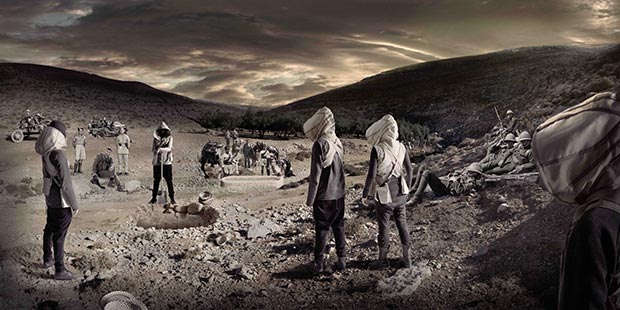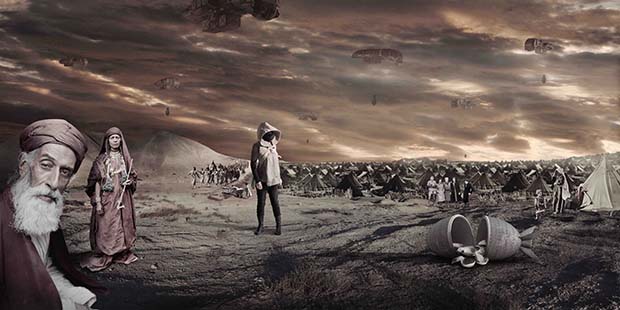
EXHIBITION Larissa Sansour ‘In the Future They Ate From the Finest Porcelain’ at Sabrina Amrani
Mar 10, 2016 Exhibition

The artist, born in East Jerusalem, on this occasion and as the centerpiece of his exhibition, presents her latest short film entitled 'In the Future They Ate From the Finest Porcelain'. It is a science fiction film, accompanied by three photographs and two installations through which the artist poses a dystopian scenario about the situation of the Palestinian people.
As in her previous video works, Sansour inmerse us into specific problems arising from this conflict, however using strategies and codes themselves away from its own media. The artist finds in science fiction the perfect way to re-introduce the viewer -overwhelmed by the repetitive images of armed conflict- post-apocalyptic CGI spaces, which ultimately are reproductions of real environments detached from a certain space and time. Also irony is a very effective vehicle in her work to connect with an audience, that after 60 years of conflict, has ceased to pay attention to the distress calls of a people continually being muted.
 Larissa Sansour, In the Future They Ate From the Finest Porcelain, FlyingSaucers / Courtesy of Sabrina Amrani
Larissa Sansour, In the Future They Ate From the Finest Porcelain, FlyingSaucers / Courtesy of Sabrina Amrani
In her previous works, 'A Space Exodus' (2009) and 'Nation Estate' (2012), Sansour explored the difficult Palestinian situation through irony imagining space exoduses or nation-states projected vertically. She presented in these videos two alternative solutions to the life of the Palestinians in Jerusalem, amendments that could satisfy the staunchest defenders of the state of Israel, but represented in themselves an impossibility for Palestinians as they involved their rootlessness. A striking but very effective artistic strategy that not only goes against the Palestinian narrative that effectively connects identity and nationalism with their region, but also evidences the Israeli tactic of concentrating the Palestinian population presence in certain remote areas from the historic center.
The land is a scarce resource, is an essential instrument of power in the building exercise of any nation. In "In the Future They Ate From the Finest Porcelain" is however time which takes center stage as opposed to the site. The past, present and future become tools of ideology control, making clear the phrase: "Who controls the past controls the future; who controls the present controls the past", as could be read on the novel 1984 by George Orwell. No doubt the construction of a national collective identity involves rescuing the lost memory, either by recovering mythology; the reinterpretation of the sacred texts; the systematic excavation of archaeological sites, or in short, by finding that footprint in the primeval sediment claiming: "we were here first."
 Larissa Sansour, In the Future They Ate From the Finest Porcelain, Burial / Courtesy of Sabrina Amrani
Larissa Sansour, In the Future They Ate From the Finest Porcelain, Burial / Courtesy of Sabrina Amrani
In 'In the Future They Are From the Finest Porcelain' the Palestinian national dream projects into an unspecified time in the future. In this way, the protagonist, draws a long-term strategy that retroactively changes the way the story will be told, affirming at the same time the legitimacy of the claims of the Palestinian people. Sansour introduces us into her film through the character of a "narrative terrorist" trying to change the history of her people through a time travel journey. A scenario in which millions of pieces of porcelain are sent from the future, and intended to legitimize the present: the ownership of a disputed territory. Sansour flips the term used in diplomacy: "facts on the ground", transforming the so-called places in new archeological deposits where porcelain pieces, marked with the distinctive keffiyeh pattern, will be buried and are found.
 Larissa Sansour, In the Future They Ate From the Finest Porcelain, Spaceships / Courtesy of Sabrina Amrani
Larissa Sansour, In the Future They Ate From the Finest Porcelain, Spaceships / Courtesy of Sabrina Amrani
Larissa Sansour in 'In the Future They Are From the Finest Porcelain', her most universal film, manages to combine the most futuristic landscapes with those described in the scriptures; hoary images recovered from old archives with newly minted images digitally created; Palestinian folk dressing clothes that seem designed for videogame heroes; an epic story with a cabinet conversation and the feeling of belonging to a group with the loss of a loved one.
A universal and timeless drama: that what we call a reason to live is at the same time a reason to die.
Comments
Add a comment